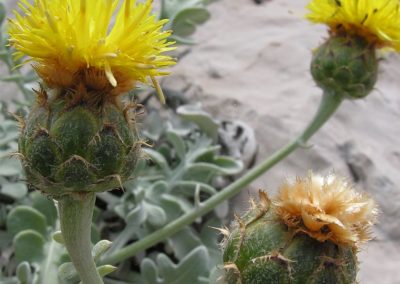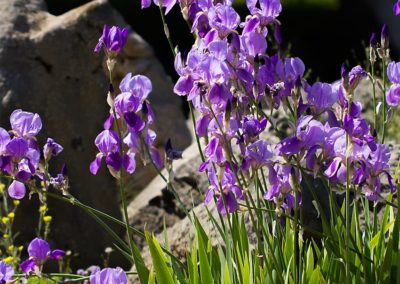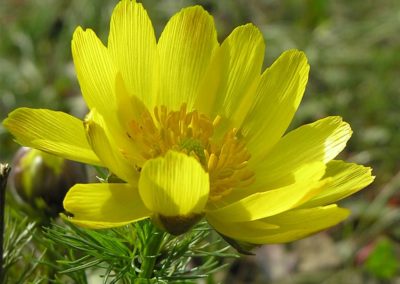

Croatian flora
Our Garden is recognised primarily for its collection of wild plants indigenous to Croatia, most of which grow on phytogeographic vegetation beds, popularly known as rockeries. The Croatian flora is the third richest in Europe (after Slovenia and Albania ), measured by the ratio between the total number of species and the total surface area of the country. This extraordinary richness is a result of a number of favourable circumstances. Croatia is situated on the boundary between the continental and the Mediterranean climatic zones and was less affected by the Ice Ages, so that many species have survived as relict species. Even though Croatia is a relatively small country, it stretches across as many as four of the nine European biogeographical regions: the Alpine, the Continental, the Mediterranean and the Pannonian. The large diversity of land relief (relatively high mountain belts, karstic fields, numerous river valleys and extremely indented coastlines with more than 1,000 islands and islets) contributes to the preservation of a large number of plant species as well as the development of endemic species.
Velebit Degenia (Degenia velebitica) is the most famous Croatian endemic plant, an inhabitant of limestone screes in the Velebit mountain. It was first noticed by Hungarian botanist Arpad Degen in 1907 who classified it into the former North American genus Lesquerella. By analyzing the herbarium specimens, Austrian botanist August Hayek realised that it was a separate genus and species.
A group rich in endemic species in Croatia are the bluebells, e.g. Croatian or earleaf bellflower (Campanula cochlearifolia)
Members of Croatian flora – many of which are endemic, rare and endangered plants, are cultivated on four phytogeographic vegetation beds (rockeries); the Eu-mediterranean and Mediterranean, the Karstic and the Sub-mediterranean rockeries.

The Mediterranean phytogeographic section
This rockery is the most recently built for those plants indigenous to the Croatian coastal area that prefer open and sunny habitats (heliophillous plants or heliophytes). Numerous donators contributed to its construction, which started in 2009 on the occasion of the 120th anniversary of the Botanical Garden. Besides financial assistance, they also donated various types of soil, gravel and rocks. According to the original design, the rockery is shaped as a miniature Croatian coast, including Istria and Mount Učka, the slopes of Mount Velebit, the Dalmatian coast, and the Konavle region with coastal mountains. Since the rockery is relatively small (colloquially called the Little Mediterranean, M2), priority was given to rare and endemic Croatian species mainly belonging to karstic grasslands and pastures, limestone crevices and sandy habitats. The first young plants were collected from their natural habitats in 2007, and the rest were transplanted from the old, shaded Mediterranean rockery (M1). About 150 species of plants, naturally growing in sunny habitats of the Adriatic coast and coastal mountains, are cultivated in this rockery today.
The most interesting plants you can see here are certainly the endemic, endangered and statutorily strictly protected ones, including Visiani’s savory (Satureja visianii), Adriatic iris (Iris pseudopallida), endemic cornflowers (Centaurea ragusina, C. friderici subsp. jabukensis, C. crithmifolia, C. spinosociliata) and bellflowers (Campanula istriaca, C. portenschlagiana, C. pyramidalis, C. austrodalmatica). On the slopes at the rear of the rockery, the endemic species native to Croatian coastal mountains, manage to grow well, e.g. Velebit degenia (Degenia velebitica) and Dalmatian cranesbill (Geranium dalmaticum). Here you can also see some common, useful species like Common sage (Salvia officinalis), Dalmatian chrysanthemum (Tanacetum cinerariifolium), ‘curry plant’ (Helichrysum italicum), Winter savory (Satureja montana, S. subspicata) and germanders (Teucrium montanum, T. polium, T. flavum, T. chamaedrys). A special place has been reserved for the small saltwater swamp that can hardly withstand the winter in this part of Croatia, so that only a limited number of perennial species is grown in it, including Sea Arrowgrass (Triglochin maritimum), Sea clubrush (Scirpus maritimus), Divided sedge (Carex divisa) and Glasswort (Salicornia europaea).
The karstic phytogeographic section
The karstic rockery is the largest and the oldest space in the Garden dedicated to indigenous Croatian species. It was built in 1927 thanks to the efforts of Prof. Ivo Horvat, a world renowned Croatian botanist, according to the design prepared by Mr. Franjo Roštapil, the Assistant Gardener. This 6 metre tall, artificial elevation was envisaged as an area for representing various plant communities: groves of Downy Oak and Hop Hornbeam, Sessile Oak and Common Hornbeam, beech, fir and dwarf mountain pine, as well as the vegetation of karstic rocks, alpine meadows and cliffs. As many as 99% of the plants seen in this rockery originate from their natural habitats across Croatia: from the nearby Mt Medvednica, but also from Samoborsko gorje, Žumberačko gorje, Ivanščica, Strahinjščica, Ravna gora, Kalnik, Klek and Velebit.
Among the numerous species in this rockery, the only Croatian monotypic genus, Degenia velebitica, truly stands out. It belongs to the cabbage family (Brassicaceae) and has yellow flowers and greyish fruits. It was formerly considered to be native only to the Velebit region, but now it can also be found in the lower areas of Mt Kapela. It is statutorily strictly protected and considered an endangered species. Croatian sibiraea (Sibiraea altaiensis subsp. croatica) is also a well-known Croatian endemic species. This low shrub with tiny white flowers, from the rose family (Rosaceae), is a relict species whose closest relatives live in central Asia and China. Winter aconite (Eranthis hiemalis) is an early spring flower that blooms very early, during late winter, when the Garden is closed to public. The critically endangered Snowdrop anemone (Anemone sylvestris) is a perennial that lives in thermophillous forests. Today it is still present in only a few locations in northwestern Croatia. A particular subspecies of the Christmas rose or Black hellebore (Helleborus niger subsp. macranthus) is common in the Croatian regions of Gorski kotar and Žumberačko gorje. It has evergreen leathery leaves and white flowers that turn pink after pollination. Hepatica (Hepatica nobilis), a relative of the anemones, is an early spring ornament of deciduous forests. Mouse thorn (Ruscus hypoglossum) is an evergreen subshrub, growing in shaded deciduous forests, distinguished by its ‘fake leaves’ (phylloclades).
The Sub-mediterranean phytogeographic section
This rockery was built from 1963 to 1965. Plants originating from the Balkans, growing under the mild influence of the Mediterranean climate, are planted here, such as those from Croatia (the mountains of Učka, Risnjak, Mosor and Biokovo), Bosnia and Herzegovina, Montenegro, Macedonia, Serbia and even Greece. Although it is quite overshadowed by trees, some interesting species can nevertheless be seen in the Sub-mediterranean rockery. The Pheasant’s eye (Adonis vernalis) was considered extinct in its natural Croatian habitats (shifting sands), but has recently been rediscovered. The Balkan bear’s breeches (Acanthus balcanicus), a massive herbaceous plant living in thickets and rocky slopes, is an interesting and highly valued horticultural plant because of its whitish-violet flowers which preserve their beauty during almost the entire vegetative season.
Ancient Greeks noticed the beauty of the Balkan Bear’s Breeches. Its leaves are carved on Corinthian capitals of numerous Greek temples. On the elevation to the west one can see an Alpine rose (Rosa pendulina), which is particularly decorative in late summer when it is full of red, ovate rose hips. Near the roses, one can also see the Savin juniper (Juniperus sabina), a beautiful shrub with horizontally spreading branches, which has been used in horticulture since ancient times. On the southern side of the rockery, there is a grey downy shrub called the Jerusalem sage (Phlomis fruticosa), which blossoms in late May or early June, when it produces whorls of beautiful yellow flowers.
The Mediterranean trees and shrubs phytogeographic section
This section, colloquially called the Mediterranean Rockery (M1), was built in 1954, when the collection of the Croatian coastal plant species in the Botanical Garden had grown so much that the nurseries became too crowded. In addition to the herbaceous plants, shrubs and woody plants were planted as well, and which, over the decades, overshadowed the major part of the rockery. This is why a new rockery was built in 2009 (M2), to be reserved for the heliophytes (‘sun loving plants’) from the Croatian coastal area, while the old rockery remained planted with coastal shrub and tree species. Nevertheless, some endemic Mediterranean herbaceous species can still be seen here, such as the Dubrovnik bellflower (Campanula poscharskyana), which naturally grows only around the City of Dubrovnik (in the Konavle region), and the statutorily strictly protected and critically endangered Dalmatian cranesbill (Geranium dalmaticum), which grows only on the Pelješac peninsula (the Sveti Ilija peak) but is known worldwide as an ornamental plant. On the partially sunlit, northern side of the rockery, there is a nice small Kermes oak (Quercus coccifera) named after the kermes scale insect that feeds on the oak’s sap.
On the northern side of the walking path (P49), there is a Strawberry tree (Arbutus unedo), a species that grows all along the Adriatic coast. In winter, it is adorned with inflorescences comprising small pale pink bell-shaped flowers that reveal its relation to the heath family (Ericaceae). It produces yellow to bright red berries, which are edible and resemble the garden strawberries in shape and size, hence its common name both in Croatian and English, namely jagodnjak or the Strawberry Tree. The rockery also includes the Evergreen oak and the Mediterranean cypress (Cupressus sempervirens), a long-living evergreen conifer whose columnar crowns are considered landmarks in numerous Mediterranean countries. One will also notice an interesting low-growing, Evergreen horsetail (Ephedra fragilis subsp. camylopoda) near the mock privets. Horsetails belong to an odd, relict group called Gnetales, plants with a series of confusing gymnosperm features in combination with those of angiosperms. The homologues of true leaves in horsetails are small leathery scales and photosynthesis takes place in their green branchlets, which are called phylloclades.
Velebitska degenija
(Degenia velebitica)
This small, cushion-like plant belongs to the cabbage family (Brassicaceae). It is adorned with many sulphur-yellow flower in early spring and later with interesting looking fruits containing four seeds. This species is a true veteran; it survives in harsh conditions of limestone screes with scorching summer temperatures and freezing winters, constantly exposed to elevated UV solar radiation. Many different survival mechanisms have been investigated, including spectacular dense trichoma (leaf hairs) cover, that protect gentle green tissues of the leaves.
The Garden is the only holder to a special licence by the State institute for nature protection to grow and sell Velebit degenia to the public, as the law forbids the exploitation of protected Croatian flora for commercial the purposes.
It is a symbol of Croatian mountains and rich Croatian flora; a relief of its flower and fruit can be seen on the Croatian 50 lipa coin!




































